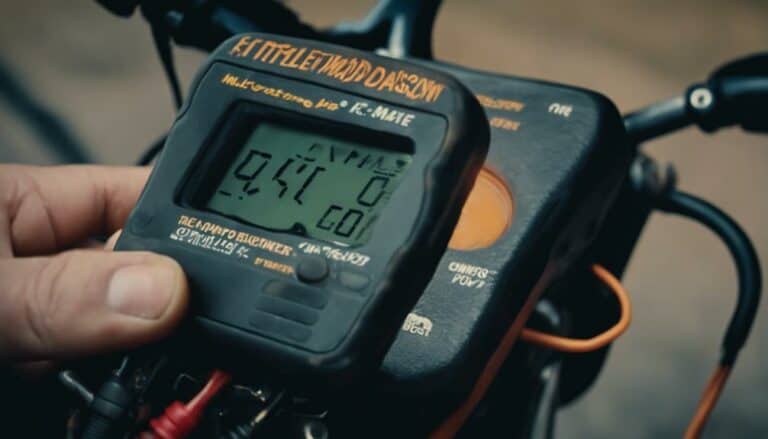When it comes to testing your Harley Davidson temperature sensor, precision is key in ensuring optimal engine performance. Start by acknowledging the sensor's crucial role, but don't stop there.
Dig deeper into the intricacies of testing methods and troubleshooting techniques to uncover a world where accuracy reigns supreme. By unraveling the mysteries behind this essential component, you pave the way for a smoother ride ahead.
Key Takeaways
- Use a multimeter to measure resistance accurately for testing the Harley Davidson temperature sensor.
- Validate sensor functionality by monitoring resistance changes with a heat gun and in boiling water.
- Ensure optimal performance by comparing sensor readings with known values or Thundermax data.
- Replacement of faulty sensors is a cost-effective solution for maintaining Harley Davidson performance.
Symptoms of Faulty Temperature Sensor
If your Harley Davidson temperature sensor malfunctions, warning lights might illuminate on the dashboard signaling a potential issue. A faulty engine temperature sensor can lead to poor mileage as it affects the fuel-air mixture, causing inefficiencies in combustion.
Additionally, the engine heat may not be regulated properly, resulting in black or gray smoke emanating from the exhaust. The engine temperature sensor plays a crucial role in ensuring optimal performance, and when it malfunctions, hard starting and rough idling are common symptoms.
Moreover, decreased engine performance can be attributed to a faulty engine temperature sensor disrupting ignition timing and fuel injection processes. It's essential to be vigilant for these signs to address any issues promptly and maintain the efficiency and longevity of your Harley Davidson motorcycle.
Proper functioning of the engine temperature sensor is vital for the overall health and performance of your bike, making it a critical component to monitor regularly.
Locating the Temperature Sensor
Located behind the horn and at the back of the front cylinder on your Harley Davidson motorcycle is the temperature sensor, easily identifiable by its resemblance to a spark plug with a plastic oval end.
When locating it, ensure you have a three-quarter-inch deep well socket to facilitate its removal. The sensor is crucial for monitoring engine temperature, so proper placement is essential for accurate readings and optimal performance.
During the removal process, be mindful of any rubber boot surrounding the sensor, as it may complicate the task of securing it back into place. Remember, the correct tools and technique are necessary to avoid any damage to the sensor or surrounding components.
Testing the Temperature Sensor
To effectively test the Harley Davidson temperature sensor, utilize a multimeter to check its resistance and observe changes when heating with a heat gun. This process helps ensure the sensor is functioning correctly and providing accurate temperature readings.
- Use a multimeter to measure the resistance of the temperature sensor.
- Heat the sensor gradually with a heat gun and monitor the changes in resistance.
- Dip the sensor in boiling water to simulate high temperatures and verify its response.
- Compare the sensor readings with known temperature values or utilize monitoring devices like Thundermax for validation.
Troubleshooting Sensor Issues
For effective troubleshooting of sensor issues, start by verifying the sensor's resistance using an ohmmeter and observing any changes when exposed to heat sources.
Using a heat gun, monitor the sensor's resistance as it heats up to detect any irregularities that may indicate a faulty sensor.
Additionally, immersing the sensor in boiling water can help confirm its functionality under extreme temperatures.
It's crucial to compare the sensor readings obtained from these tests with known temperatures to aid in diagnosing any sensor problems accurately.
Utilizing advanced monitoring gadgets like Thundermax can provide real-time temperature data, enabling precise testing and identification of sensor issues.
Replacing the Temperature Sensor
If you have determined that your Harley Davidson temperature sensor is faulty based on the sensor's resistance readings and performance under heat tests, replacing the sensor is a cost-effective solution to ensure optimal performance and maintain the reliability of your motorcycle.
Here are some key points to consider when replacing the temperature sensor:
- The cost of a new Harley Davidson temperature sensor is approximately $20.
- Labor for replacing the sensor typically ranges around $50.
- Additional diagnostic costs may apply if done at an auto repair shop.
- Replacing a faulty sensor is a cost-effective solution for optimal performance.
Conclusion
In conclusion, when it comes to testing your Harley Davidson temperature sensor, it's crucial to follow the proper diagnostic procedures to ensure accurate results.
Don't let faulty sensors 'put the brakes on' your engine performance. By carefully inspecting, testing, and replacing as needed, you can keep your bike running smoothly and efficiently.
Remember to consult manufacturer guidelines for the best practices in sensor maintenance and replacement.

